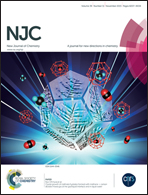Zinc(ii) and cadmium(ii) complexes of N-terminally free peptides containing two separate cysteinyl binding sites†
Abstract
The hexa- and hepta-peptides CSSACS-NH2 and ACSSACS-NH2 have been synthesized by solid phase peptide synthesis and their zinc(II) and cadmium(II) complexes studied by potentiometric, NMR spectroscopic and ESI MS techniques. Both peptides have outstanding zinc(II) and cadmium(II) binding affinity but their coordination chemistry is different. In the case of the hexapeptide, the amino terminus is the primary metal binding site in the form of a stable (NH2,S−) 5-membered chelate supported by macrochelation via the distant cysteinyl residue. The heptapeptide ACSSACS-NH2 is a slightly less effective metal binder but its coordination chemistry is more versatile. The thiolate groups are the primary binding sites for both metal ions and an 18-membered (S−,S−) macrochelate is the favored coordination mode of the peptide. In slightly basic samples the deprotonated amino group can also contribute to metal binding. Moreover, the interaction of the terminal amino-N and the thiolate-S− of the Cys(2) moiety can promote the deprotonation and metal ion coordination of the amide group between these residues. This reaction results in the formation of the (NH2,N−,S−) fused chelates supported by the thiolate of the distant cysteinyl residue. Zinc(II) induced deprotonation and coordination of amide groups have already been described in various peptides of histidine, but in the case of cadmium(II) this is the first example for the formation of a Cd–N(peptide amide) bond.


 Please wait while we load your content...
Please wait while we load your content...